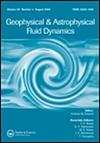Floating tracer clustering in divergent random flows modulated by an unsteady mesoscale ocean field
IF 1.1
4区 地球科学
Q3 ASTRONOMY & ASTROPHYSICS
Geophysical and Astrophysical Fluid Dynamics
Pub Date : 2020-07-09
DOI:10.1080/03091929.2020.1786551
引用次数: 5
Abstract
ABSTRACT Clustering of tracers floating on the ocean surface and evolving due to combined velocity fields consisting of a deterministic mesoscale component and a kinematic random component is analysed. The random component represents the influence of submesoscale motions. A theory of exponential clustering in random velocity fields is applied to characterise the obtained clustering scenarios in both steady and unsteady time-dependent mesoscale flows, as simulated by a comprehensive realistic, eddy-resolving, general circulation model for the Japan/East Sea. The mesoscale flow field abounds in transient eddy-like patterns modulating and branching the main currents, and the underlying time-mean flow component features closed recirculation zones that can entrap the tracer. The submesoscale flow component is modelled kinematically, as a divergent random velocity field with a prescribed correlation radius and variance. The combined flow induces tracer clustering, that is, the exponential growth of tracer density in patches with vanishing areas. The statistical topography methodology, which provides integral characteristics to quantify the emerging clusters, uncovers drastic dependence of the clustering rates on whether the mesoscale flow component is taken to be steady or time-dependent. The former situation favours robust exponential clustering, similar to the theoretically understood case of purely divergent and zero-mean random velocity. The latter situation, on the contrary, hinders exponential clustering due to significant advection of the tracer out of the nearly enclosed eddies, at the rate faster than the clustering rate.非定常中尺度海洋场调制的发散随机流中的漂浮示踪团簇
摘要分析了漂浮在海面上的示踪剂在由确定性中尺度分量和运动随机分量组成的联合速度场作用下的聚类。随机分量表示亚中尺度运动的影响。本文应用随机速度场的指数聚类理论,描述了稳定和非稳定随时间变化的中尺度流的聚类情景,并通过日本/东海综合现实的涡旋解析环流模式进行了模拟。中尺度流场充满了调制和分支主流的瞬态涡状模式,潜在的时间平均流量分量具有封闭的再循环区,可以捕获示踪剂。亚中尺度流分量的运动学模拟,是一个具有规定的相关半径和方差的发散随机速度场。复合流动诱导示踪剂聚集,即示踪剂密度在具有消失区域的斑块中呈指数增长。统计地形方法学提供了量化新出现的群集的整体特征,揭示了群集率对中尺度流分量是稳定的还是依赖于时间的强烈依赖。前一种情况有利于稳健的指数聚类,类似于理论上理解的纯发散和零平均随机速度的情况。相反,后一种情况阻碍了指数聚类,因为示踪剂以比聚类速度更快的速度从几乎封闭的涡流中产生了明显的平流。
本文章由计算机程序翻译,如有差异,请以英文原文为准。
求助全文
约1分钟内获得全文
求助全文
来源期刊

Geophysical and Astrophysical Fluid Dynamics
地学天文-地球化学与地球物理
CiteScore
3.10
自引率
0.00%
发文量
14
审稿时长
>12 weeks
期刊介绍:
Geophysical and Astrophysical Fluid Dynamics exists for the publication of original research papers and short communications, occasional survey articles and conference reports on the fluid mechanics of the earth and planets, including oceans, atmospheres and interiors, and the fluid mechanics of the sun, stars and other astrophysical objects.
In addition, their magnetohydrodynamic behaviours are investigated. Experimental, theoretical and numerical studies of rotating, stratified and convecting fluids of general interest to geophysicists and astrophysicists appear. Properly interpreted observational results are also published.
 求助内容:
求助内容: 应助结果提醒方式:
应助结果提醒方式:


